Archive for Maintenance
September 14, 2006 at 10:13 am · Filed under Maintenance
We’re back to “Cat in the Hat” weather here. I am reading blogs from friends in California, Colorado, and Florida, and all of them are enjoying wonderful warm — even hot — weather. Yesterday it never broke 61 here and rained most of the day. My instincts tell me to flee for the south, because the freedom to seek out better weather is a privilege of Airstreaming. But Eleanor says otherwise. We still have a lot to do here.
Eleanor is starting a curtain project. We’ve never been fond of the curtains that came with our trailer, so she has found something funky to replace them. She’s going to back the fabric with light-blocking material so we can get real darkness in the bedroom when we want to.
She’s also come up with a better solution to our bath mat problem. We bought a small standard rubber-backed bath mat some months ago. But when it got dirty, we found it was very difficult to get cleaned on the road. When we stop for laundry we don’t want to toss it in with the clothes, and yet running a separate wash for it wastes time and resources. Worse, it can’t be dried in the dryer due to the rubber backing, so it ends up wet for days before we can use it again.
Instead, she bought two small towels that match our bathroom decor, and she’s simply sewing them together back to back. This makes them thick enough to serve as a mat and it’s easily washable. I’ll show you a picture when it’s done.
Emma is working on a project today too: making a suncatcher out of glass beads.
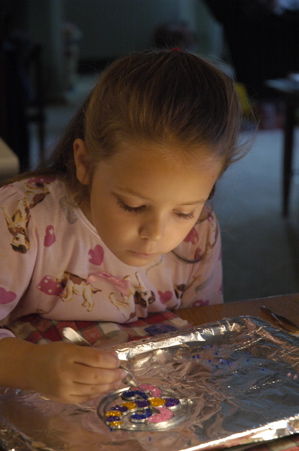
One of my projects is to search for things in the trailer we can dump in storage or give away, to lighten our load and free up storage space. The latest thing is my Windows laptop, an elderly Pentium III running Win 98. I kept it only because there was one program I needed to run once every three months for the magazine. I’ve since found a better version that runs on Mac, so the Windows laptop is history, saving us about 6 lbs.
That may seem like a ridiculous economy in an 8000 lb trailer, but every ounce counts. It’s the little things that add up surreptitiously. I like to keep the trailer light. We can carry up to about 2000 lbs (including optionally installed equipment like solar panels and extra batteries, plus fresh water and propane). In reality, by weighing our rig at truck scales every few months, we’ve found that our typical load is only about 1600 lbs, and that’s as a full-timing family of three, running a business!
That’s largely due to scrupulous attention to what we carry. I see people with chainsaws, cinder blocks, hatchets, hundreds of feet of hose, cast iron cookware, solid wood flooring (added in after-market), heavy custom furniture, giant air compressors, full mechanic’s chests of tools, and racks of canned goods. No wonder so many people are driving around with overweight rigs.
Even if you don’t haul a lot of obviously heavy stuff, culling down the excess quantities of lightweight stuff is still important. We don’t carry five pairs of shoes when we only need three. Tools are kept to a basic kit suitable for most situations, not every possible situation. Paper is culled out often — recycling magazines and scanning almost everything else. Even Emma’s rock collection is limited to samples < 1″ in size, and the collection is reduced by half every time she flies back to Vermont. My goal is to take at least 100 lbs out of the trailer while we are here. I think we are probably halfway there.
Solar report: with gloom and rain all day, we captured only about 10 amps all day. Our battery bank is down to about about 57% (reported). In fact, we have more power than that. We initially set the TriMetric monitor to report only about 60% of our actual capacity, so it reads conservatively. That way, we don’t overdraw the batteries. If it hits 50% reported, I’ll probably plug the trailer in for a full charge. If so, it would be the first time we’ve gotten that low since we installed the solar panels and four batteries in May.
August 30, 2006 at 9:49 am · Filed under Maintenance
Some of our blog readers have questioned whether we are doing maintenance on the Airstream as well as the cars. The answer is that we aren’t doing much right now, because we do it as we go. As full-timers we don’t often have the opportunity to stop and do a big maintenance session, and we don’t have the luxury of holding off on things until it is convenient. So we do what we can when we can.
The wheel bearings were re-packed when we did the disc brake conversion in March. Our tires and wheels have seen plenty of maintenance lately (I hate to even think about it!) In general, the running gear is in good shape.
We usually clean things inside and out as we see the need. For example, I cleaned the exterior refrigerator compartment just a few weeks ago, when I noticed it was getting filled with dust and crud. Today Jay & Cherie suggested checking the water heater for mineral deposits, which is a good idea. We’ve never drained it, since we never winterize the trailer. I’m hoping the water filter we put on our incoming water line has kept the minerals to a minimum.
Ditto for lubing the locks and latches. I keep several kinds of lube in my tool bag: grease, Reese hitch lube, silicone-based liquid lubricant, and liquid graphite. The latter two are good for locks, latches, and hinges. I lubed the hitch ball (which is hidden under the Hensley hitch all the time) just a couple of weeks ago a a rest stop in New York. It’s a messy job that needs to be done every few months if you full-time, or perhaps annually if you don’t. While I was at it, I took the opportunity to check all the bolts and pins on the hitch.
These sorts of items go hand-in-hand with a good general check everytime we hitch up. As you know, I now check all the lug nuts and tire pressures as part of the pre-departure checklist. Pilots of aircraft do a “walk-around” check before takeoff, and I do the same thing. I look for open windows or vents, things that are loose or hanging, obstacles under the trailer, drips from unexpected places, tire damage, etc. In general, everything should be clean, tight, and dry.
The Honda Prelude has been condemned by the inspector. The rust is worse than we thought. A portion of the underbody frame collapsed when the car was put on the lift. It won’t pass inspection without at least $1k worth of work, and then it will need more (timing belt, etc) very soon. We are going to put it out to pasture and find another car for economical local commuting next summer.
August 29, 2006 at 9:55 am · Filed under Maintenance
… what bugs me about Vermont. It’s a lovely place and you should come visit — really! — but the weather is always a crapshoot. Today, more gray and drizzle, but at least it’s not cold.
The weather forecasters here are perennial optimists. They have to be. So “partly cloudy” is code for “You’ll be darned lucky to see the sun today!” “Chance of rain” translates to, “Good weather for mushrooms.”
I remember in Big Bend when the opposite occurred. There, “10% chance of rain” was their hopeful phrase. They said that every day when we were there in February, and we never even saw a cloud the entire time.
Yesterday we got the big service on the Nissan. At 30,000 miles an expensive service interval comes up: automatic transmission flush, coolant flush, oil change, rear differential fluid change, engine belts, numerous systems checks, and many small part replacements (radiator cap, distributor cap, rotor, spark plugs, engine air filter, fuel filter, wiper blades, cabin microfilter) Some of these items only apply when you’ve been towing, as we have.
We just put new tires on last Thursday, also. Between the tires and the 30,000 mile service, the total is over $1100. It’s a hard bill to swallow, but our experience has shown us that preventative maintenance is absolutely essential, given all the miles and desolate areas we travel through. I talked to Bert about it over dinner on Sunday night and he felt the same way. “We maintain the heck out of that truck!” were Bert’s words — but when you roam the country for months on end, utterly dependent on one vehicle, it doesn’t seem like skimping on maintenance is a wise idea.
Today our local car (an elderly Honda Prelude) is in the shop for its inspection. The poor thing is 15 years old, burns a quart of oil every 500 miles, has a tough case of rust along the passenger-side rocker panel, 144k miles on the clock, and it is due for an expensive timing belt replacement and an exhaust pipe.
Every year at inspection time we consider whether to fix it again or push it off a cliff. But despite its flaws it runs beautifully, gets great gas mileage, and is a lot of fun to drive. I haven’t seen much on the market that can compare under $16,000 (new). Eleanor says if it were a vintage Airstream I wouldn’t hesitate to dump $10k into it to restore it and keep it on the road. I suppose that’s true, but a 1991 model is not vintage, either. It’s just a cool sporty car that I could probably replace for $2000 with a rust-free one from the south. So today is decision day … we’ll know more when the garage calls and tells us what is needed to get it to pass Inspection.
July 28, 2006 at 7:00 pm · Filed under Maintenance
… where the rain came in (metaphorically). We don’t actually have a hole in the Airstream, but we certainly had a few holes in our systems lately.
We packed up and left Cherry Creek today for Colorado Springs. But before we left, I picked up my Powerbook with the new 100 gigabyte hard drive, and a copy of Tiger too. That’s two items fixed from our bad luck spell: computer and phone. Eleanor also got me a very good t—– wrench (I still can’t say the word, but you know what I’m talking about) at Sears. Cost about $65 on sale, and I think the regular price was about $90. Well worth it given the alternative.
So I before we pulled out, I added two items to our pre-departure checklist: checked the lug nuts on the wheels, and checked the air pressure in all the tires. We won’t have THAT disaster again if I can help it.
Fred C wrote me to say “thanks for the KITA” (Kick In The ***). My hard drive failure inspired him to get serious about backing up his stuff too. I hope our disasters have been at least useful in preventing other people from having similar problems. That’s why I go out on a limb and admit all the stupid things I’ve done and the things that have gone wrong.
Now that my Mac is almost fully set up, I’m installing a program called Silverkeeper by LaCie. It is an automatic backup program, very easy to use and fast. I’ll run it at least twice a week to back up my files to the external LaCie hard drive. It works with any type of drive, including CDs and DVDs.
Our campground in Colorado Springs is not pretty. It’s sort of a dirt parking lot with views and sounds of a busy highway. The wi-fi does not reach us, predictably, and since I needed to download some big files I’m at the Panera Bread. We didn’t have much choice in places to stay, since everything else seemed to be booked up for the weekend. Fortunately, we are only spending two nights at this campground and then moving along to another one in the Colorado Springs area.
Tomorrow we’ll have some fun. It’s about time. There’s a lot to do in the area of Colorado Springs and I plan to check some good stuff out! I’ll also resume taking photos for you.
July 23, 2006 at 10:27 am · Filed under Maintenance
I’ve replaced all six studs and lug nuts on the offending aluminum wheel. The parts store did not have enough lug nuts for the other (steel) wheel on that side, so we are going cautiously proceed without replacing the lugs on that one for now. I’ll be checking torque very often.
Colin Hyde was on the phone this morning with some helpful advice also. It gets detailed, but the gist of it was to be sure the lugnuts were tightened evenly and absolutely on center. I’ve done that.
I did loosen and re-tighten the lugnuts on the steel wheel and found them to be VERY tight. They are now re-torqued to the proper amount. I also checked the other wheels on the driver’s side, which have not been touched by mechanics with air wrenches. All good.
More later if I can get online!
July 22, 2006 at 6:49 pm · Filed under Maintenance
There’s a force in the universe that is out to get us, but we aren’t going to let it win!
Today started out fine. We went to Fossil Butte National Monument, which is a fairly obscure national park outside Kemmerer. That made a good addition to our national parks Passport book. Emma really seemed to get into the cool fossils they have in the new Visitor Center.
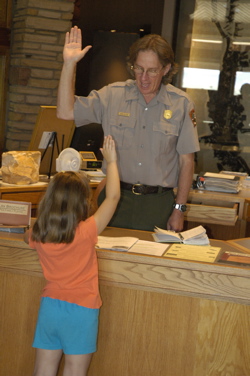
Emma takes the pledge for another Jr Ranger badge
Then we headed to downtown Kemmerer to hit the public library. I updated the blog and Eleanor and Emma read stories in the kids’ room.
Then we drove about 80 miles to Green River, WY, which is along I-80. It’s pretty lonely country, so I decided to stop in Green River for lunch around 2 pm. That gave another chance to check the lugnuts…
… and one of them twisted right off.
The stud had broken right in the middle.
Well, you can imagine my reaction to that. I’ll skip the gory details, but after about two tense hours and several phone calls, we ascertained the following:
1) Both of the wheels on the entry door side of the Airstream had been tightened by mechanics using air impact wrenches. After tightening the nuts, they followed up with a torque wrench to assure 110 ft-lbs of torque.
2) NEVER NEVER NEVER let anyone tighten the lug nuts on your Airstream with an air impact wrench unless they are using the wrench only to spin the nuts on loosely. The air impact wrench will overtighten them. Torquing them after that is utterly pointless — they’re already overtorqued.
3) All 12 of the studs and lugnuts on the two right side wheels of our Airstream need to be replaced, as a precaution.
4) Nobody in Green River, WY could possibly get us into their shop for at least a few days.
This put us in a tight spot. Driving the Airstream with a known problem like this (and one stud already failed) would be asking for another wheel separation like yesterday. But staying here to wait for service wasn’t much of an option either.
We had two basic choices:
1) Deflate the known bad tire by 10-15 lbs to lessen its load, and proceed SLOWLY to the nearest campground, about six miles away, then wait several days for service.
2) Fix it ourselves.
I got mad about the lackluster interest I received from the RV repair shop, the local tire shop, and two other repair shops I called. When I get mad, I get busy. So we towed the Airstream less than a mile to the NAPA Auto Parts and got busy.
First, I called David Tidmore again, and Brett, and got advice. Then we bought 15 replacement studs at the NAPA store and backed the Airstream into a spot next to the store. I broke out my tools and made sure I had what was needed to do the job: a hammer, a torque wrench with extension, socket for the lugnuts, some blocks to pull the Airstream up on (so I could remove the wheel), a sacrificial nut, and mental gumption.
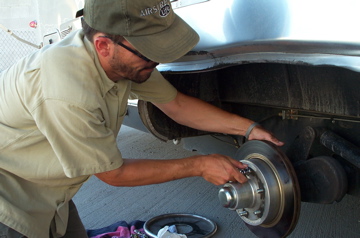
Rich exercises his non-existent handyman skills
The process of removing a stud and replacing it is fairly straightforward. You bang the old stud out with the hammer, and then slip in the new one. The sacrificial nut is used to pull the stud through until it is seated properly. We pulled the emergency brake cable on the disc brake system to lock the wheels in place during this operation (that’s OK to do with disc brakes, it won’t burn out).
At 4 pm, the NAPA store owner closed up, but he came by to make sure we were OK before he left. He said we could stay overnight if we needed to, and he’d be back at 9 a.m. tomorrow. Unfortunately, I let him get away before remembering to buy the replacement lug nuts. I tried to recycle the old ones, but two of them were in terrible condition and I decided to suspend work for tonight. I’ll buy a completely new set tomorrow and finish the job.
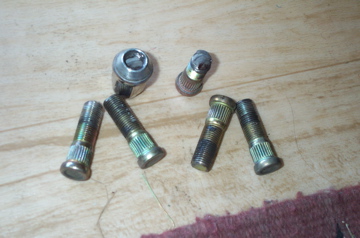
Studs I removed. Note the broken one at top right, with the matching nut at left.
So now it is 6:40 pm and we are parked on concrete next to NAPA and a drive-through liquor store. Fortunately, the liquor store is closed too. It is not all that bad here — I’ve been in worse campgrounds — and except for the heat we are doing fine. As I’ve told people, when you have a problem in your Airstream, you’re still home with all the conveniences, so how bad can it be?
OK, there was a moment when Eleanor said, “I want a hotel room with air conditioning and a pool!” And as tempting as that is (it is 98 degrees in the trailer at this moment), I think we will resist the urge. After all, this is home, and I wouldn’t feel right abandoning my home just because it had a little problem.
So we’ve opened up the vents and windows and are cooling things down now. I’ve got a cold Jarritos Toronja (grapefruit soda), Emma is doing homeschooling (but she doesn’t know it), Eleanor is avidly reading something trashy by Eric Lustbader, and pretty soon I’ll plug in the iPod to listen to some music.
In other words, we are going to make lemonade out of this and not let this incredible streak of mishaps drive us to insanity. We’re going to fix the trailer once and for all, and get on with the business of having fun.
One other thing: thanks to my friends David, Brett, Terry, and Rich C for their support on the phone the past few days. Thanks to Carol, Marc, Terrie, and everyone else who wrote in with supportive comments. Without you guys I’d probably be a lot more stressed about this stuff. And thanks to whoever in this strip mall left their wi-fi network open, because otherwise I wouldn’t be able to get online tonight to post all this!
July 21, 2006 at 10:30 pm · Filed under Maintenance
Our streak of bad luck has continued, but we are learning to focus on the bright side.
This morning, we packed up and departed from this week’s home in Victor ID. We chose a gentler route than we’d come in, which took us over the low Pine Creek Pass and southward. Ascending the pass was easy, and we were winding down the other side at a leisurely 35 MPH when we heard a tinny noise and saw in the right side mirror, almost simultaneously, a black-and-silver object go flying off into the weeds.
For a moment I was confused, thinking it looked and sounded like the little disposable charcoal grill we had packed in the rear compartment. Had the compartment come open? I quickly pulled over and walked back to the trailer.
As I was walking, a discussion I’d had with my friend Doug Dukane in Tampa flashed through my mind. Doug had the unfortunate experience of having two wheels come off his 34-foot Airstream, leaving him and his family stranded by the roadside in Ohio. The cause was a mechanic who didn’t tighten the lug nuts properly on the wheels. The damage to his trailer was extensive ““ when the wheels depart an Airstream, they usually take some of the aluminum side sheet with them.
So when I got to the passenger side of the trailer, I wasn’t surprised by what I saw. The forward wheel was gone. It had left us for a ravine about 200 feet up the road.
A motorcyclist pulled up. “Something came off your trailer!” Yeah, I know. He left, and a man in a pickup truck stopped by. He blocked traffic for us, while I went up the hill to retrieve the missing wheel.
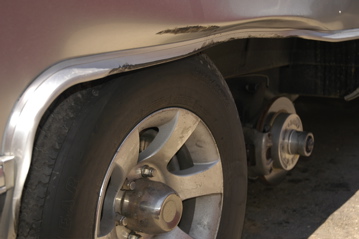
The damage showed what happened. One lug nut apparently came off its stud. The remaining studs were unable to take the strain, and snapped off cleanly at their bases. The wheel flopped around for a moment during this process and then bounced out, damaging the Airstream’s body as it left.
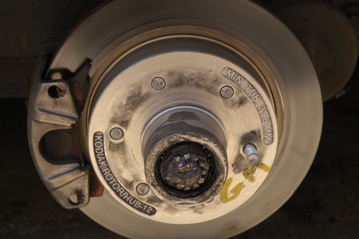
Note five studs snapped off, one stud left
The strange thing was that the wheel that left us wasn’t the one we’d had worked on last week. I would have sworn that if a wheel was to come off, it would be the last one that had been removed. But it was the wheel forward of that one instead.
This was one of those “It can’t be happening” moments. Sure, I’d seen many trailers where a tire had blown out or shredded, leaving carnage in its wake. But our lug nuts were well-seated, having been worn in over many thousands of miles of travel. They had been re-torqued when we installed the disc brakes in May. All the nuts were present when we left the campground (I checked as part of my routine pre-departure walkaround). How could a nut have come off completely in just seven miles?
We weren’t in the right place to be doing forensic analysis, I realized. We were parked blocking most of one lane of a winding mountain road, far out of reach of cell phone service, AAA, or any other service that might rescue us. Our spare was already in use (we haven’t had a chance to replace it since the drywall screw of last week).
Now, in my opinion, the most critical thing about an emergency situation is how you and your group react to it. Regardless of how serious a situation is, you probably can make it better with the right response, and with the wrong response you can make any situation much worse.
There is a process involved here. Step One is to calm down. Don’t yell at anyone, since that usually makes things worse. Step Two is to mentally step away from the situation, as if you’d had a night to sleep on it, and then look at it again from a big perspective. I try to defocus my attention on the proximate issues that tend to make me react emotionally, whatever those issues might be: someone bleeding, bent metal, unhelpful bystanders, etc.
In this case, the guy with the truck who was blocking traffic for us started saying, “That disc is red hot! There’s something wrong with your brakes. That’s what made the wheel come off!” I felt the disc, and while it was hot, it wasn’t “red hot.” It was as hot as you’d expect a disc to be after descending a 5% grade for two miles in 85+ degree temperatures. (Later analysis showed the disc brake to be operating normally.)
I also try to avoid being pressured to do something that might make the situation worse. For example, if someone is shouting, “Get it off the road, you’re blocking traffic!” you might hastily jump in the truck and pull your trailer further and make things much worse. My feeling is that traffic can wait a minute while I figure out what’s going on.
When I ran through that mental process, I realized that I needed to assess the damage to ensure the trailer was towable. A quick check in the wheelwell assured me it was. Nothing was dragging, and the hydraulic lines to the disc brakes were intact. Once I knew the trailer was OK, and I could tow it with three wheels, I felt better. All we needed to do was get it to a tire shop and they could fix it. Fortunately, an Airstream can be driven with one wheel off, as long as you go slowly.
It occurred to me that if we lost another tire for any reason, we would be completely stuck by the side of a road and in a situation where we could not even be able to stay in the trailer due to the tilt of the road. So, what to do to ensure this wouldn’t happen?
Three things: 1) I could drive slowly. Sure, traffic would pile up behind us and the drive would be akin to water torture, but I’d rather have a few annoyed drivers behind us than be sitting by the road with another tire gone.
2) The load each tire can take is dependent on air pressure. Since three tires now have to do the work of four, it’s a good idea to make sure the tires are inflated to their maximum pressure, which is usually 65 psi. Read the side of your tire to be sure. I already had 60 lbs in each one but in retrospect I could have added a little insurance by putting the additional air in.
3) I checked the torque on the remaining three wheels ““ and it’s a good thing I did. All of the lugnuts on the wheel that had been removed last week were loose too! That’s not uncommon when a wheel is removed. I should have checked the torque before we left Victor, since that was about 50 miles after the wheel service was done.
Continuing in the same direction was out of the question. We were headed for Swan Valley, a town of 200 people and very little else. We drove another ½ mile down the road to the first turnout and executed a very slow, tight 180 degree turn. Then we drove at the sedate pace of 25 MPH all the way back up the pass, down the other side, past our campground in Victor, and another eight miles to Driggs, where we pulled into Kaufman’s OK Tire.
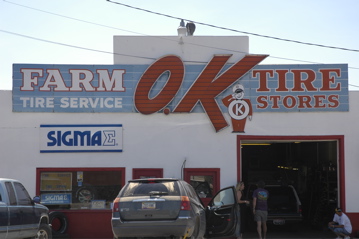
Eleanor and I, although completely stressed out, tried to relax and think during the long slow drive back to Driggs. I tried not to get anxious about things I could not control, like the probable cost of repairing the body damage. Focusing on the good things in life helps avoid “catastrophizing” (obsessing on what’s gone wrong). So I counted our blessings: everyone was fine, we were going to be able to get it all fixed, there was a tire store only 14 miles away, and it was another gorgeous sunny day.
When we arrived at Kaufman’s OK Tire, both Eleanor and I had our plan. I explained to the tire shop owner what had happened and outlined the repairs we’d need. Eleanor took Emma into the trailer and made a special lunch for us ““ comfort lunch.
And of course, everything turned out fine. We spent the afternoon walking the streets of Driggs, which is something we’d wanted to do all week anyway. It was a bonus, really. We dropped in on the rock shop and Emma entertained some grandparents while we were there. It was over 90 degrees, so we dropped in on the old-fashioned soda fountain and got some great cold treats: Bumbleberry ice cream for Eleanor, Oreo cookie shake for Emma, and a frosty Lime Cooler for me.
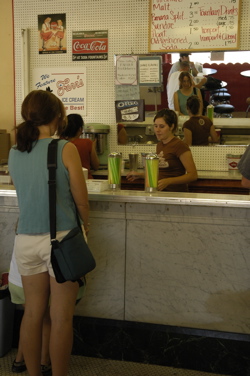
I made a trip to the local auto parts store to get a torque wrench. I’m going to check the torque on those nuts EVERY trip from now on! And then I spent about an hour with the very friendly service tech David, who explained to me in detail everything he was doing, in his classic Mexican accent.
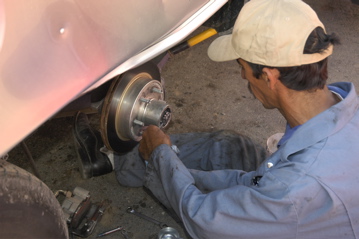
The wheel did a lot of damage, and yet we were lucky. As it wobbled off, the wheel’s stud holes were destroyed, making the entire rim into expensive aluminum trash. It also knocked off the dust cap that covers the wheel bearings, and we never did find the hubcap in the tall weeds. Five of the six studs were snapped clean off, and the one remaining was badly mangled. The stud ripped a large hole in the tire, too. Finally, the wheel bent the aluminum trim piece that surrounds the wheel well, and bent the side of the trailer too.
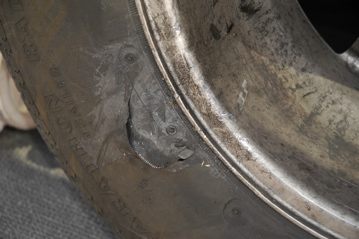
The stud ripped a hole in the tire as it came off
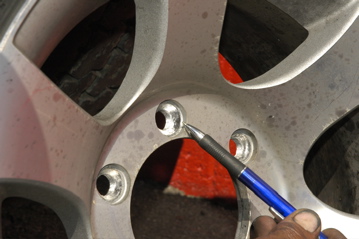
Stripped out and enlarged in all six holes. This $300 wheel is trash.
So why were we lucky? Well, the damage to the Airstream could have been worse. Blown tires often shred before they come off, ripping apart the wheelwell area and even destroying dump valves and parts of the belly pan. Our body damage was limited to a bit of bent metal and a piece of trim. This may be fixable without replacing the aluminum side of the trailer.
The bill at the tire shop was $264, for two tires (I got a replacement for the spare, even though we don’t have a rim for it at the moment), bearing re-pack, valve stems, wheel balance, seal, studs, lug nuts, dustcap, and disposal of two tires. We’re riding on the steel spare rim at the moment. I called David Tidmore at Roger Williams Airstream and asked him to bring a replacement aluminum rim and hubcap to the Rocky Mountain Vintage Rally, where we will meet him in two weeks.
So our string of bad luck has continued, but I prefer to look at it as a karmic balancing. We’ve had a charmed life in the past year, with very little going wrong. As my good friend Adam said, “Even if you stayed home, the water heater would have broken or something.” In other words, stuff happens no matter where you are. Our house has given us very little trouble over the past few months, and I guess we have to expect a little grief once in a while.
The work at the tire shop was completed by 4:45, and we decided to do a little driving this evening. I stopped every 25-35 miles to check the torque on the wheels with my new torque wrench. It’s now 10 pm, and we are parked behind a gas station in the town of Kemmerer, WY, about 150 miles from Driggs. This town is known as the birthplace of JC Penney, and the “mother store” is still here in town. Tomorrow night we may drop in for a peek before we get out on the road again.
« Previous entries ·
Next entries »












